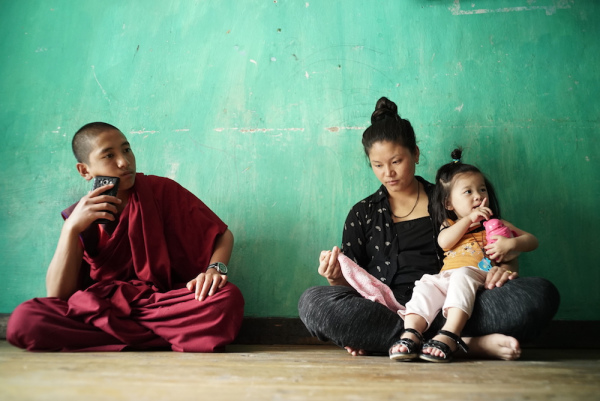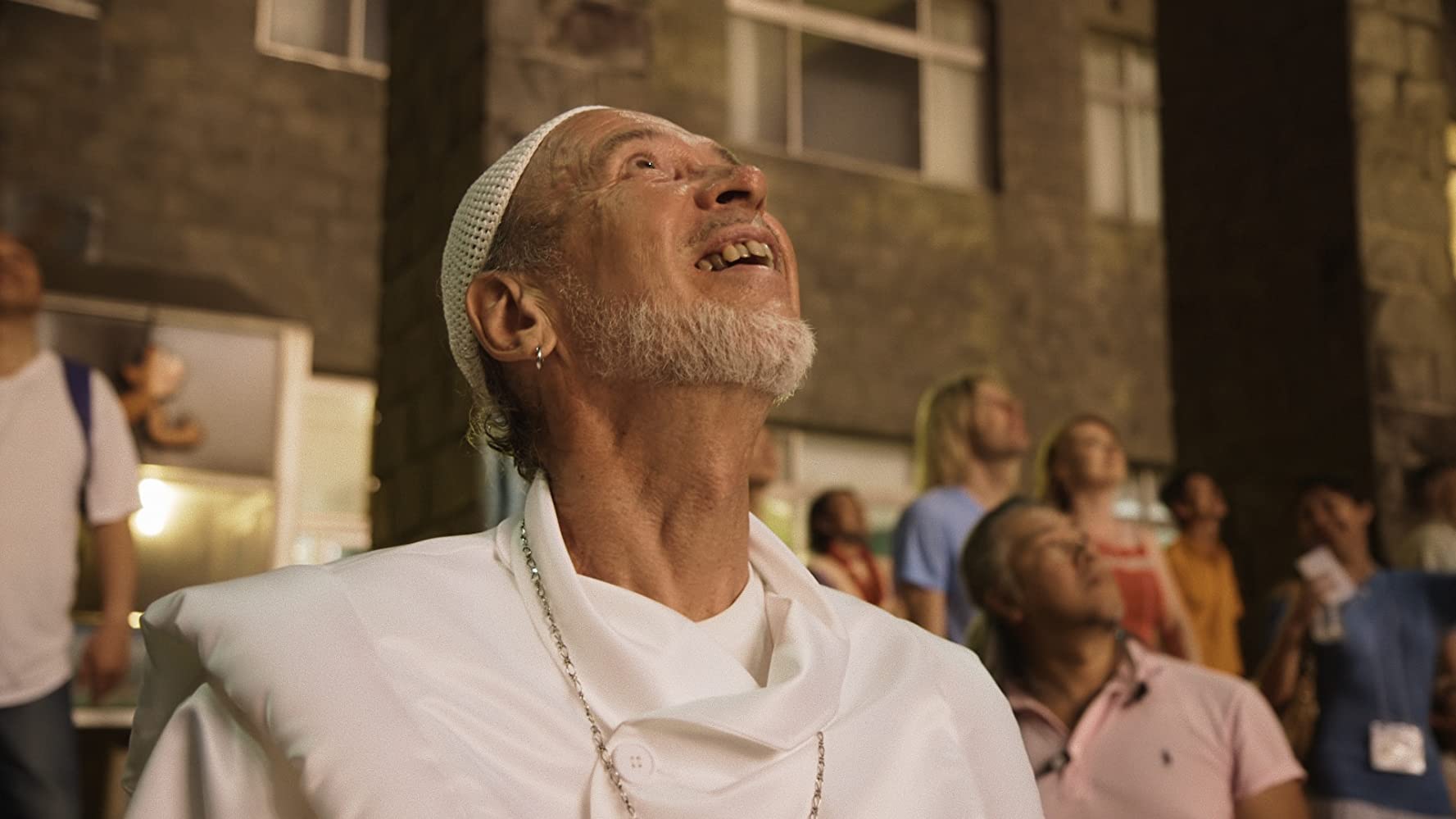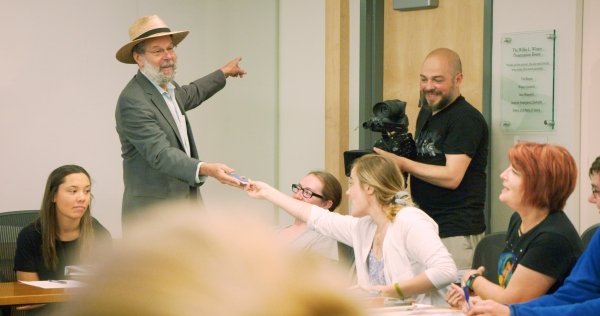
We do not need the recent weeks to understand that we are going straight towards an online society. The Thessaloniki Documentary Festivals offers quite different wavelengths to touch this sensitive subject of the actual transformations of our society.
One of the last places which promises not to be touched by online receptions, seems to be a remote Buddhist monastery deep in the Himalayas. Wrong. The astonishing film Sing me a Song by Thomas Balmès, presented in Thessaloniki´s International competition, shows us a group of young boys preparing to be monks who – during the recitation of prayers – use their smart phones and are totally captured by them. One of them, fascinated by songs, gets in contact with a female singer living in Thimphu, the country’s capital, through WeChat. He falls in love and gets ready to leave his protected space to find her, but reality has bad news for him. This woman has not told him that she is already a mother. All her questions for him concern his ambitions and career. The young man get lost in a world he was not prepared for, having been cheated by his online perceptions. Passing through video arcades and discotheques, where he shyly sits among girls, all of them holding their cell phone in their hands. The last scene of this documentary suggests he will choose to make his way back to the monastery.

Often in a much profounder and definitely strategic way, virtual worlds colliding with reality. In The Prophet and The Space Aliens by Yoav Shamir, we follow a quite ambitious young man finally getting media attention by claiming to have been in contact with extraterrestrials, who have given him the mission to prepare their return to earth. To think this will never work is being optimistic. On the contrary, in the France of the 70s, many UFO stories were circulating and soon the first believers showed up. Suddenly the one-man show became a nationwide enterprise with hundreds of followers.
The Israeli filmmaker, known for his critical approach concerning Israel’s occupational politics, got invited and welcomed into the circle of Raël, born 1946 as Claude Vorilhon in Vichy and raised in Ambert (both France), a definitely sensitive, airily charismatic and simply amiable man with a sense of humor. We see this leader of the movement carrying just his own name often with his guitar in his hands between his admires. Of course, getting a documentary about himself made is one of his hidden motives. In addition, as we understand later, Raël is ill, so his wish to find a neutral person for a friendly talk and the possibility to create an audio-visual testament seems understandable enough and worth to open up to his universe, but with much caution, as Shamir discreetly indicates.
Quite a challenge for a documentary filmmaker, and definitely it’s not Yoav Shamir’s aim to destroy the concept and story Raël´s group. Instead, he opens up question of truth and belief on a larger scale, especially through conversations with the professor of the history of religion, Daniel Boyarin (UC Berkeley), who first of all points out that the founding stories of the world religions all have a comparable degree of naivety. Let’s imagine a documentary filmmaker would be around following the first steps of the founder of a world religion. So Shamir’s film becomes more an investigation of what and why people want to belief and need to belief, asking how to find a way to get structure and sense in a person’s life. According to Boyarin, devaluation and defamation is always possible about everything. He also reminds us that all wars were started by people believing in God, so “God” is creating violence on earth. For peace and love, we don’t need a God.
Concerning Raël´s followers, one reality turns out to be the decisive one. Raël practices and celebrates the joy of life, dance and meditation, sharing, and most of all free sexuality between the members in mutual agreement. Not to forget the promise of immortality, not as post stage resurrection, but on the base of scientific research, likewise supported by some of his followers. Part of his activities were to build a clinic in Burkina Faso, to give mutilated women a change to recover. On the other side, he is using the media strategically and this time gets worldwide attention with the fake news to have cloned a human being. Shamir seems to follow the protocol of not asking too many questions.
Whatever, for his followers there are enough reasons to stay. Some of them freely admit: even if the origin story is wrong, the reality keeps them engaged. For most of them, he offers an unexpected and normally unattainable personal freedom. We remember the huge media attacks against Bhagwan Shri Rajneesh and his followers, accused for a sharing community and free sexuality. The main accusations concerned his personal luxurious life style, long before others were added, concerning the crimes committed by some of his key collaborators.
Charismatic and mystical leadership is also part of Raël´s movement. It seems to be a necessary element of spirituality itself. Also, he isn’t passing up comfortable living conditions and the sympathy of some beautiful women who are dedicated to him. But joy is a shared reality of the entire group, so far we can understand them. Unfortunately, Shamir leaves out information about the financial basis of the community. Definitely, the members must make it possible. However, to leave the group seems possible at all time without repercussions.
It would be definitely hypocritical to attack a financial model of an alternative society based on joy and sharing surrounded by a capitalistic scenario, where most of its participants lose their lifetime to get some money together, from which they finally not even can offer themselves a slight part of the concrete joys and happiness that Raël´s movement offers. Of course, some remarks about health care, and the treatment of the older ones are missing in Shamir´s documentation. This would be decisive to get a more precise view on the realities inside.

That beliefs gets personal play as an acceptable part of each ones auto-confirmation, is an undermining, disastrous tendency for democracies when it comes to news and the function of the media. In online times, the quantity of news viewers produce the “facts” and journalist are paid to confirm them. Investigative journalism and propounded text production are the first victims in the line of the new perception habits. The Italian documentary filmmaker Alberto Puliafito looks in Slow News for solutions facing this eminent problem. As a fatal circular reaction, the threatened journalism is losing the public trust. Even more dangerous, as a further consequence, is that the value of truth itself gets into a crisis. The quantity of people who just want to their beliefs confirmed is growing.
“Slow News” is the title of a book published in 2014 by Peter Laufer of Oregon University. Two Italian journalists, Alberto Puliafito himself and his collaborator, both working for Milan’s online website Blogo, one of Italy’s largest online journals, which sometimes publishes as many as 400 articles a day, found here stimulation enough to propose the concept of Slow News at the International Conference for Journalism in Perugia, Italy.
Starting by mentioning some strategies of fake news, which got quite successful by a reciprocal citation up to higher levels of national papers, Puliafito takes the problem to a larger level. The daily overwhelming of information itself is already a caustic problem. A fact can be interpreted in different, sometimes even opposite ways. Only contextualization can validate facts. Also wrong causal connections between “facts” are well-known strategies.
On their world wide research for solutions the Blogo journalists find journals, which drastically had reduced the quantity of published text by offering to their subscribers a well-researched contributions, which they can send for free to their community. The receiver will know from whom he got the article and then maybe join the group. Another tendency is to re-estimate the aesthetics of the “Slow Food” movement and to create new connections between journalism, sharing, community and lifestyle. The easiest way to start is in friendly meetings between the journalist and their public, which is also a good opportunity for fruitful exchanges.
Also offering another kind of news in referring to realities before or after the spectacle (crime, violence, wars, disaster, etc.) is a notable missing link in the media landscape; for example, to go back to the life-after-the battle-scenarios, where the real long-term problems for the victims start. Another impact would be to focus on the long-term essentials, which aren’t in the daily news charts, for example to cover the facts of climate change, and not just their surface events, like demonstrations and statements.
But the decisive question waits for an urgent solution, how to finance profound journalism. The French economist Julia Cagé proposes to make Facebook and Co., which are already making their profits on the basis of journalists’ works, pay taxes in Europe and the States to finance independent journalism. The organization in charge of distributing this money to the wealth of different information media should of course be monitored carefully. She remembers that the crisis of information is one of the most important reasons for an upcoming populism.
Puliafito brings together representatives from The New York Times, Buzz Feed News, La Stampa, Corriere delle Sera and from many smaller media outlets to let them exchange and develop their ideas. As editor and co-founder of the Slow News movement in Italy in 2015, Puliafito’s position as a film director helps the cause. His documentary opened up contacts between activists and therefore provides a strong impact to let the Slow News movement grow.
Dieter Wieczorek
© FIPRESCI 2020
Edited by Karsten Kastelan
